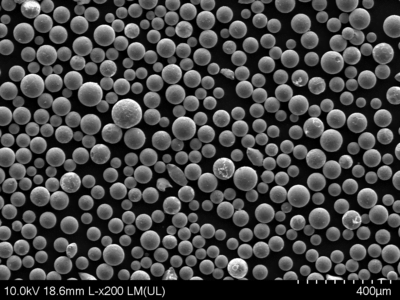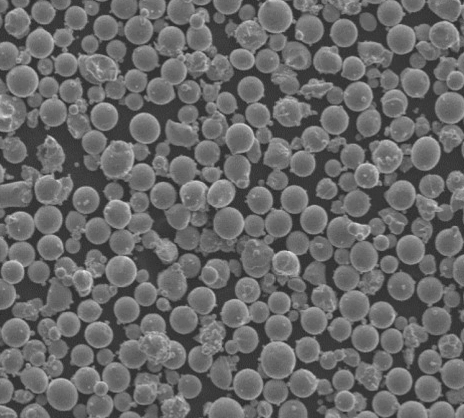Bem-vindo ao fascinante mundo do metallic powders! If you’ve ever been curious about the tiny particles that make up some of the most innovative materials in modern manufacturing, you’re in the right place. This guide will delve deep into metallic powders, exploring their types, compositions, properties, applications, and much more. Whether you’re a seasoned engineer, a curious student, or just someone with a keen interest in materials science, there’s something here for you.
Overview of Metallic Powders
Metallic powders are fine particles of metals used in various industrial applications. These powders are essential in manufacturing, offering unique properties that make them suitable for creating complex shapes, achieving specific mechanical properties, and producing materials with enhanced performance characteristics. From additive manufacturing (3D printing) to powder metallurgy and beyond, metallic powders play a crucial role in modern technology.
Principais pormenores
- Definição: Finely divided particles of metal.
- Métodos de Produção: Atomização, redução, eletrólise, liga mecânica.
- APLICAÇÕES: Additive manufacturing, powder metallurgy, thermal spraying, MIM (Metal Injection Molding).
- Vantagens: High precision, material efficiency, complex shapes, customizable properties.
- Desvantagens: Cost, handling hazards, powder consistency.

Tipos de Pós metálicos
1. Alumínio em pó
Aluminum powder is lightweight, corrosion-resistant, and highly conductive. It’s widely used in automotive parts, aerospace components, and fireworks.
Composição: Pure aluminum or aluminum alloys.
Propriedades:
- Leve
- Condutividade térmica e elétrica elevada
- Boa resistência à corrosão
APLICAÇÕES:
- Peças automotivas
- Componentes Aeroespaciais
- fabricação aditiva
2. Copper Powder
Copper powder is known for its excellent electrical and thermal conductivity. It’s a key material in electronics, batteries, and conductive inks.
Composição: Pure copper or copper alloys.
Propriedades:
- Excelente condutividade eléctrica
- Alta condução térmica
- Antimicrobial properties
APLICAÇÕES:
- Eletrônica
- Batteries
- Tintas condutoras
3. Pó de ferro
Iron powder is versatile, used in various applications from automotive to industrial manufacturing. It’s known for its magnetic properties and strength.
Composição: Pure iron or iron alloys.
Propriedades:
- High magnetic permeability
- Strong and durable
- Rentável
APLICAÇÕES:
- Metalurgia do pó
- Magnetic materials
- Peças automotivas
4. Titanium Powder
Titanium powder is highly valued for its strength, lightweight nature, and corrosion resistance, making it ideal for aerospace and medical implants.
Composição: Pure titanium or titanium alloys.
Propriedades:
- Alta relação resistência-peso
- Excelente resistência à corrosão
- Biocompatível
APLICAÇÕES:
- Componentes Aeroespaciais
- Implantes médicos
- fabricação aditiva
5. Níquel em pó
Nickel powder is used in batteries, catalysts, and electronics due to its excellent corrosion resistance and high-temperature stability.
Composição: Pure nickel or nickel alloys.
Propriedades:
- Excelente resistência à corrosão
- Estabilidade a altas temperaturas
- Good mechanical properties
APLICAÇÕES:
- Batteries
- Catalisadores
- Eletrônica
6. Stainless Steel Powder
Stainless steel powder combines the benefits of iron and chromium, offering corrosion resistance and strength. It’s used in a wide range of applications.
Composição: Iron-chromium alloys.
Propriedades:
- Resistência à corrosão
- alta resistência
- Resistência ao desgaste
APLICAÇÕES:
- Dispositivos médicos
- Food processing equipment
- fabricação aditiva
7. Cobalt Powder
Cobalt powder is crucial in high-performance alloys and battery materials, known for its magnetic properties and high melting point.
Composição: Pure cobalt or cobalt alloys.
Propriedades:
- Ponto de fusão elevado
- Propriedades magnéticas
- Resistência ao desgaste
APLICAÇÕES:
- Ligas de alto desempenho
- Batteries
- Cutting tools
8. Zinc Powder
Zinc powder is widely used in protective coatings and batteries due to its anti-corrosion properties and electrochemical behavior.
Composição: Pure zinc or zinc alloys.
Propriedades:
- Anti-corrosion properties
- Good electrochemical behavior
- Alta reatividade
APLICAÇÕES:
- Protective coatings
- Batteries
- Chemical reagents
9. Tungsten Powder
Tungsten powder is used in high-temperature applications and radiation shielding, valued for its high density and melting point.
Composição: Pure tungsten or tungsten alloys.
Propriedades:
- Alta densidade
- Ponto de fusão elevado
- Resistência excelente ao desgaste
APLICAÇÕES:
- Aplicações a altas temperaturas
- Radiation shielding
- Cutting tools
10. Magnesium Powder
Magnesium powder is lightweight and has high specific strength, used in aerospace, automotive, and electronics industries.
Composição: Pure magnesium or magnesium alloys.
Propriedades:
- Leve
- High specific strength
- Good machinability
APLICAÇÕES:
- Componentes Aeroespaciais
- Peças automotivas
- Eletrônica






Propriedades e características de Pós metálicos
| Tipo | Composição | Propriedades | APLICAÇÕES |
|---|---|---|---|
| Alumínio em pó | Pure aluminum or alloys | Leve, condutor, resistente à corrosão | Automotive, aerospace, fireworks |
| Pó de cobre | Pure copper or alloys | Conductive, antimicrobial | Electronics, batteries, conductive inks |
| Pó de ferro | Pure iron or alloys | Magnetic, strong, cost-effective | Powder metallurgy, automotive |
| Titânio em pó | Pure titanium or alloys | Strong, lightweight, biocompatible | Aeroespacial, implantes médicos |
| Níquel em pó | Pure nickel or alloys | Corrosion-resistant, stable at high temps | Batteries, catalysts, electronics |
| Pó de aço inoxidável | Iron-chromium alloys | Corrosion-resistant, strong, wear-resistant | Dispositivos médicos, transformação de alimentos |
| Cobalto em pó | Pure cobalt or alloys | High melting point, magnetic, wear-resistant | High-performance alloys, batteries |
| Zinco em pó | Pure zinc or alloys | Anti-corrosion, electrochemical | Protective coatings, batteries |
| Pó de tungsténio | Pure tungsten or alloys | High density, high melting point, wear-resistant | High-temp applications, radiation shielding |
| Magnésio em pó | Pure magnesium or alloys | Lightweight, high specific strength, machinable | Aerospace, automotive, electronics |
Applications of Metallic Powders
fabricação aditiva
Additive manufacturing, or 3D printing, is revolutionizing how we produce complex parts. Metallic powders are essential in this process, allowing for high precision and material efficiency. Metals like titanium and aluminum are particularly popular in aerospace and medical industries due to their lightweight and strong properties.
**Metalurgia do Pó**
Powder metallurgy is a manufacturing process where metallic powders are compacted and sintered to create solid parts. This method is cost-effective and allows for producing components with intricate shapes and specific properties, commonly used in automotive and industrial applications.
Pintura Térmica
Thermal spraying involves spraying metallic powders onto surfaces to create coatings that enhance wear resistance, corrosion resistance, or thermal insulation. This technique is widely used in aerospace, automotive, and industrial machinery.
Moldagem por Injeção de Metal (MIM)
MIM combines the versatility of plastic injection molding with the strength and integrity of metal. Metallic powders are mixed with a binder to create a feedstock, which is then injected into a mold. This process is ideal for producing small, complex parts with high precision.
Batteries
Metallic powders like nickel and cobalt are crucial in battery production, especially in rechargeable batteries like lithium-ion. These metals provide the necessary electrochemical properties to store and release energy efficiently.
Eletrônica
Copper and silver powders are commonly used in electronics due to their excellent electrical conductivity. They are used in conductive inks, printed circuits, and various electronic components.

Comparing Metallic Powders: Advantages and Disadvantages
| Tipo | Vantagens | Desvantagens |
|---|---|---|
| Alumínio em pó | Leve, resistente à corrosão, condutor | Can be expensive, handling hazards |
| Pó de cobre | Excellent conductivity, antimicrobial | Oxidizes easily, relatively expensive |
| Pó de ferro | Cost-effective, strong, magnetic | Prone to rust, requires protective coating |
| Titânio em pó | Elevada relação resistência/peso, biocompatível | Caro, reativo em forma de pó |
| Níquel em pó | Corrosion-resistant, high-temp stability | Expensive, health hazards if inhaled |
| Pó de aço inoxidável | Resistente à corrosão, forte | Expensive, harder to machine |
| Cobalto em pó | High melting point, magnetic, wear-resistant | Expensive, toxic if not handled properly |
| Zinco em pó | Anti-corrosion, good electrochemical behavior | Can react with moisture, handling hazards |
| Pó de tungsténio | High density, high melting point, wear-resistant | Very dense, hard to work with |
| Magnésio em pó | Lightweight, high specific strength, machinable | Highly reactive, flammable in powder form |
Especificações, tamanhos, graus, normas
Especificações e tamanhos
| Tipo | Intervalo de tamanho | Graus comuns | Padrões |
|---|---|---|---|
| Alumínio em pó | 1-100 µm | 1050, 1100, 2024 | ASTM B928, ISO 6361 |
| Pó de cobre | 0.5-45 µm | C11000, C10100 | ASTM B170,ISO 4503 |
| Pó de ferro | 1-200 µm | A1000, ASC100.29 | ASTM B783, ISO 4497 |
| Titânio em pó | 10-500 µm | CP1, Ti6Al4V | ASTM B348, ISO 5832-2 |
| Níquel em pó | 2-150 µm | Ni201, Ni205 | ASTM B330, ISO 6284 |
| Pó de aço inoxidável | 5-150 µm | 304L, 316L | ASTM A276, ISO 4954 |
| Cobalto em pó | 1-100 µm | CoCrMo, CoCrFeNi | ASTM F75, ISO 5832-12 |
| Zinco em pó | 0.5-50 µm | Zn22, Zn94 | ASTM B860, ISO 3549 |
| Pó de tungsténio | 0.1-200 µm | W1, W2 | ASTM B777, ISO 6848 |
| Magnésio em pó | 1-500 µm | AZ31B, WE43 | ASTM B107, ISO 16220 |
Fornecedores e informações sobre preços
| Fornecedor | Pós metálicos Available | Gama de preços (por kg) | Sítio Web |
|---|---|---|---|
| Materiais avançados | Aluminum, Titanium, Copper, Nickel | $20 – $200 | www.advancedmaterials.com |
| Pós metálicos globais | Iron, Stainless Steel, Zinc, Magnesium | $10 – $150 | www.globalmetalpowders.com |
| Powder Alloy Corporation | Cobalto, Níquel, Tungsténio | $50 – $300 | www.powderalloycorp.com |
| AMETEK Produtos metálicos especiais | Aluminum, Iron, Stainless Steel | $30 – $250 | www.ametekmetals.com |
| Fabrico de pós metálicos | Copper, Zinc, Iron, Nickel | $15 – $180 | www.makinmetals.com |

Perguntas Frequentes
| Questão | Resposta |
|---|---|
| What are metallic powders? | Finely divided particles of metals used in various industrial applications. |
| How are metallic powders produced? | Common methods include atomization, reduction, electrolysis, and mechanical alloying. |
| What are the main uses of metallic powders? | Additive manufacturing, powder metallurgy, thermal spraying, metal injection molding, and more. |
| What are the benefits of using metallic powders? | They allow for high precision, material efficiency, and the creation of complex shapes. |
| Are there any disadvantages to using metallic powders? | They can be costly, pose handling hazards, and require consistent quality control. |
| How should metallic powders be stored? | In a dry, cool place, away from any sources of ignition, and in tightly sealed containers. |
| Can metallic powders be recycled? | Yes, many metallic powders can be recycled, depending on the metal and the application. |
| What safety precautions are necessary when handling metallic powders? | Use protective gear, ensure proper ventilation, and follow all safety guidelines to prevent inhalation and fire hazards. |
| What industries benefit most from metallic powders? | Aerospace, automotive, electronics, medical, and industrial manufacturing. |
| How does the particle size of metallic powders affect their use? | Smaller particles offer higher surface area and reactivity, while larger particles may provide better flow characteristics. |
Conclusão
Metallic powders are a critical component in modern manufacturing, offering unique properties and capabilities that traditional bulk metals can’t match. From their use in innovative additive manufacturing processes to their essential role in everyday products, metallic powders continue to push the boundaries of what’s possible in material science. Understanding their types, properties, and applications can open up a world of possibilities, whether you’re looking to improve product performance, explore new manufacturing techniques, or simply expand your knowledge.
Sobre a 3DP mETAL
Categoria do produto
CONTACTE-NOS
Tem dúvidas ? Envie uma mensagem para nós agora mesmo! Após o recebimento de sua mensagem, nós processaremos sua solicitação com toda a equipe.
